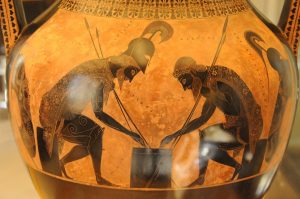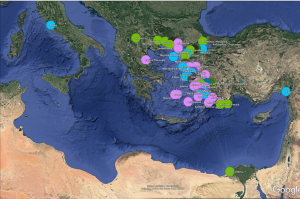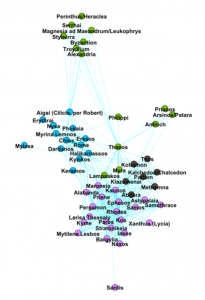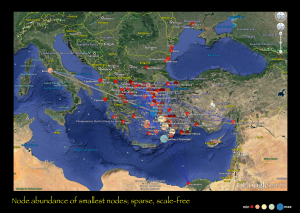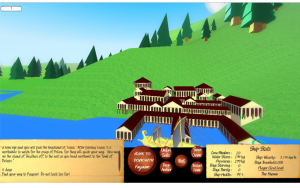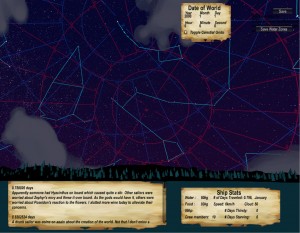This was an AIA lecture at the 2018 annual meeting, and places Sailing with the Gods in the context of the scholarly gaming community today.
A growing body of scholarship reflects the potential of serious games to generate meaningful data regarding human behavior. These games focus on war, ecology, behavioral economics, and cognitive science, with outcomes for education, training, and policy analysis.[i] The range of fields means that gaming applications for an archaeology of religion offers interdisciplinarity beyond the collaboration between programmers and scholars of antiquity, and is positioned to harvest insights from studies of the living. Four categories from those studies offer particular relevance for gaming and ancient religion: these can be characterized as (1) ground truth, (2) crowd sourcing, (3) challenging assumptions, and (4) representation.
“Ground truth” refers to the reliance on historical probability for generating meaningful outcomes, an issue that casts light on the parameters of achievable verisimilitude.[ii] War games had their origins in 19th century Prussian Kriegsspiel, iron bars laid on a map to contemplate military strategy. While these are minimally illusionistic, they are interactive rather than merely illustrative, and thus offer a measure of both player agency, and the permeability of the boundaries between the game and the real world.
https://www.youtube.com/watch?v=U7d0GUOz6ak
Today’s war games include Kandahar, emphasizing military staff management of counterinsurgency operations; Battle for Baghdad; Algeria, Labyrinth, and Andean Abyss focus on the causes and dynamics of terrorism. Visually sophisticated as these are, their playing relies heavily on collaboration, feedback and verbal interaction and problem solving (colloquially known as BOGSAT: Bunch of Guys Sitting Around a Table). The data they yield on human choices is the first step in further analysis and debriefings. [iii]
Real-play rather than role-play inform Alternate Reality Games (ARG) a category that includes Jane McGonigal’s World without Oil and Mary Flanagan’s POX: Save the People. [iv] These games invite player input to solve problems in an alternative but plausible world. In WWO, players respond to a world in oil shock by posting videos, images and blogs on a website.[v] In POX, participants cooperate to vaccinate and cure people until a disease is contained.[vi] These games seek not the training of specialists but the crowd-sourcing of ideas that respond to real-world problems: the value is directly correlated to the creativity and multiple perspectives, not of the designers, but the players.[vii] The value of both real-play games and war games, additionally, derives from their power to help the participants critically examine their own assumptions. Of war games, Vice Admiral Ann Rondeau emphasized that they illuminate what the players do not know: because of this they help explore nonconventional challenges.[viii]
Gaming takes place in a virtual world: the views of the relationship between the visual and the actual may be divided broadly into two camps, dynamicist and simulationist. The dynamicist model (a Gestalt view, like Fantasy Kommander above) focuses on how we acquire meaningful perception in an evidently chaotic world. Our perceptions of the world begin with the body, and are always only partial: in this regard, the cognitive limitations of the online environment are consonant with lived experience.[ix] The focus on the corporeality of our understanding creates significant common ground between games and archaeological studies of ritual: both are invested in questions of materiality and embodiment, and in the centrality of context as the creator of meaningful relationships. The dynamicist view also embraces the Brownian motions that arise in the course of game play, the patterns that are not rule-bound or predictable.[x] Unpredictability is central to gaming, and arises from the agency of players who make choices that respond to emotions, perceptions, and narrative as well as quantitative benefits of ‘leveling up’. Constikyan has noted that simulation is actually improved by simplicity, as this allows players to focus on the actual issues and concerns of the situation: Rommel and Montgomery didn’t focus on the buttons on the uniforms as much as on water for battalions.[xi]
The simulationist, in contrast, digs deep into the potential for increasing degrees of accuracy as digital technologies advance: characterized dismissively as “hobbyists’ and ‘rivet-counters”, they are engaged with a drive for maximum accuracy that also characterizes the digital reconstruction of archaeological sites. Archaeogames, such as virtual Çatalhöyük in Second Life show in the video above by Colleen Morgan, share in the critiques of this approach. The drive for accuracy demands levels of data that exceed what is available, and enormous input of time and energy; the constructions mask the unevenness, partiality and complexity of the ancient materials; programmers play a large role in determining outcomes, so that the stakes for effective collaboration between digital and scholarly contributors, when they are not the same individuals, rises precipitously. [xii] The criticisms are balanced with the potential to generate new insights regarding materiality of objects in context, interactions within built environments, and the potential for public outreach and pedagogy; they facilitate multiple perspectives and alternate narratives.[xiii]
The focus on perception and cognition offers one of the most promising places for theorizing when it comes to the relationship between religion and gaming: both explore the uncanny power of the non-present and re-presentational – the ludic space. McGonigal has noted that the gaming world is more empowering than the merely embodied one. Malaby reaches a similar conclusion, arguing from Weber’s notion of the cultural status of disorder: the rational and the efficient, however valorized, do not produce meaning. Ritual exceeds them in this, but gaming is even more productive.[xiv] Games share with rituals the quality of being structured and rule bound, but their outcomes by definition are unpredictable, allowing each player to move from the rational into the disordered spaces where meaning is created. Resonant with our definitions of religion in archaeological spaces, games share the characteristics of spaces separated from the outside world, access restricted to other voices engaged in that alternative reality, focused attention, and intensified experiences, with a reliance on highly condensed cultural phenomena of myth and iconography. The ludic is neither entirely idiosyncratic, nor random: it is as culturally embedded as is language, with marked connections to embodiment and to the formation of narrative.[xv]

Inscription recording theoroi-proxenoi (?) from Kos, Bargylia, Klazomenai, and an association of Dionysiac artists. Image used by kind permission of Nora M. Dimitrova
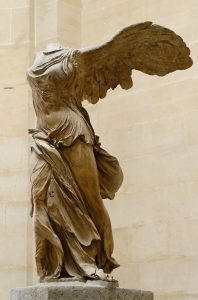
The project of today’s paper is an experiment in using a gaming program to model the effectiveness of proxenia in constructing the sealanes and maritime networks of the ancient Mediterranean. Maritime mobility was a social as well as technological achievement: information sharing and non-aggression were as key to its success as the skill of ship builders and the strength of the rowers. Scholars from Weber and Monceaux onward have noted the potential for proxenia to ensure maritime safety by setting up interstate structures for collaborative interpersonal interactions. One of the great challenges in the investigation of proxenia is the lack of historical narratives describing its use. Proxenic inscriptions are formulaic: the most detailed praise the recipients’ euergetism and may detail some benefits. They outline the structure of the institution and its geospatial reach, but leave to the historical imagination the agency of its actors, and the moments of interpersonal interaction in which its benefits were put to use.
The game had its origin in social network analysis of the epigraphic record of proxenia from the mystery cult of the Great Gods of Samothrace. Both the initial project, and its translation into gaming, highlight the issues of big data approaches to ancient religion. SLIDE 9 The proxenic network of the island extended to some 116 cities, and 819 individuals – risibly small by modern standards, but well within the norm for archaeological networks.
The outcomes have been promising, as they reveal previously unanticipated patterns. Aigai and Thasos play unanticipated roles in connecting separate neighborhoods within the network. Both are at the geospatial edges of our map, and neither are especially rich in inscriptions – an outcome that casts down the gauntlet for closer historical analysis. Fruchterman analysis reveals that the closest communities within the network are not those which are geospatially proximal.
This corresponds to patterns within hunter-gatherer cultures, and supports the hypothesis of the significance of information sharing through Samothracian ties, as news from a distance is more reliant on highly crafted channels. The network overall emerges as both sparse and scale free, suggesting patterns of preferential attachment which open the door to using mathematical analyses to model the system’s emergence. The idea of emergence is especially relevant for Samothrace’ promise, as the inscriptions on which we reconstruct the network are Hellenistic, though the promise of the rites was well known already in the fifth century BC.
The caveats, however, are significant. From the perspective of epigraphy, the amount of contested data is unwieldy: the record is partial (as the island’s lime kilns remind us), toponymns are often indeterminate, and there is a significant debate about the historical relationship between theoria and proxenia for Samothrace. Headers on some of the 28 block grant inscriptions clarify that the two were offered in tandem, but not every header is extant.[xvi] This has raised the possibility that every theoros on Samothrace was also a proxenos.[xvii] The difference between a liberal and a conservative estimate significantly shifts the amount of data on which we build. This uncertainty, perhaps ironically, directs us to the arguments in favor of statistical approaches: as tools for modeling the probabilities of interaction, they are appropriate for the investigation of agency that is shaped, but not constrained, by social structures. They have a long history of use in mediating between theoretical frameworks and the large but partial datasets that emerge from fieldwork.
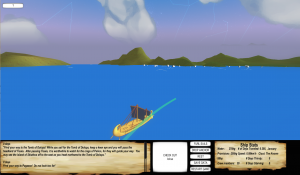 An appeal to gaming, at first glance, compounds the problematics of our network analysis: it increases the epigraphic database, adds an ancient narrative, and integrates the choices of contemporary players in a simulated world. Samothrace was only one among many centers granting proxenia, so we position it, in the game, among the other proxenic networks of the ancient world. The game at this point includes 249 cities and 130 individuals, each of whom comes with a city-appropriate biography.[xviii] Games need stories: we chose the Argonautica, which offers legendary initiates, paradigmatic first sailors, a Hellenistic floruit contemporary with the rites, production for the Ptolemaic audience who were great supporters of the mysteries, and a story focused on the same sea lanes as Samothrace.
An appeal to gaming, at first glance, compounds the problematics of our network analysis: it increases the epigraphic database, adds an ancient narrative, and integrates the choices of contemporary players in a simulated world. Samothrace was only one among many centers granting proxenia, so we position it, in the game, among the other proxenic networks of the ancient world. The game at this point includes 249 cities and 130 individuals, each of whom comes with a city-appropriate biography.[xviii] Games need stories: we chose the Argonautica, which offers legendary initiates, paradigmatic first sailors, a Hellenistic floruit contemporary with the rites, production for the Ptolemaic audience who were great supporters of the mysteries, and a story focused on the same sea lanes as Samothrace.
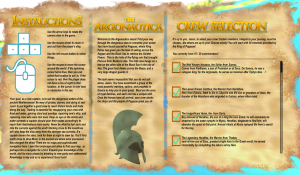 Players assume Jason as their avatar, and select crew members from the epic, from one Samothracian block grant, or from other cities with active proxenic networks. Each crewmember brings with him the proxenic network of his home city; a complex algorithm quantifies the value of proxenia for participants as they move from one port to the other. This translates into exemption from port taxes, easier flows of information in port, and better prices in the market.[xix] Note that ‘gameplay’ is an experience that is simultaneously free and rule-bound: players are encouraged to make choices that deviate from Jason’s route. What they share with Jason is an ambition for kleos or (in our game) klout. The role of proxenia in structuring interactions is not, however, a matter of player choice, but built into the system.[xx]
Players assume Jason as their avatar, and select crew members from the epic, from one Samothracian block grant, or from other cities with active proxenic networks. Each crewmember brings with him the proxenic network of his home city; a complex algorithm quantifies the value of proxenia for participants as they move from one port to the other. This translates into exemption from port taxes, easier flows of information in port, and better prices in the market.[xix] Note that ‘gameplay’ is an experience that is simultaneously free and rule-bound: players are encouraged to make choices that deviate from Jason’s route. What they share with Jason is an ambition for kleos or (in our game) klout. The role of proxenia in structuring interactions is not, however, a matter of player choice, but built into the system.[xx]
The object of the game is to get famous, get rich, and don’t die – all while moving through space. Players may level up by (1) supplying the biological imperatives of food, water and rest for the crew (2) erecting shrines and monuments (3), getting rich, (4) the combined klout of one’s associates, and (5) overcoming the risks of storms, disease and pirates (43 Hellenistic pirate events are embedded in the system)
The context of these actions is a virtual environment that – within the necessarily simplified parameters of gaming – simulates the risks, benefits, network formation and topography of the sea of which Samothrace was a part. The Unity platform integrates the large, complicated data sets for geospatial realities, social narratives and networks, meterological and astronomical data. The terrain is scaled and georeferenced using satellite imaging data, accurate to a resolution of roughly 1km. The stars were programmed using a predictive model of axial precession determined by NASA, so that they are in the appropriate positions for the year 200 BC. NASA was our source for the caloric and water requirement to keep our sailors going.
When it comes to an archaeo-game for proxenic networks, our goals are closer to the simulations for epidemiological studies than they are to the reconstructive and VR technologies used in archaeological contexts,[xxi] as we are focused on the flow of information and patterns of social interaction. And the sheer scale of our game – reaching from Colchis to Italy to Alexandria – means that we take a dynamicist rather than a purely simulationist approach (though we do plan to refine our port models considerably) Our ultimate goal is the generation of sufficiently robust data regarding player choices to offer an alternative set of data for network formation in the ancient sea, to be compared with the outcomes of our network analysis – putting to use the principle of serious games, that the raw data from the game are one step in our analysis, but far from a final answer. And we have learned much already from the embodied reality of sailing on a virtual sea: none of us had anticipated the critical nature of water supplies, for example, but a host of early playthroughs, in which we were continually losing crewmembers to dehydration, made us take a step back and realize how frequent the need was to put in to land.
In terms of the study of religion, finally, this game lets us focus on an aspect of the divine far beyond the context of a sanctuary or a ritual act. The proxenia decrees granted by the city of Samothrace represented the civic realization of the island’s mystic promise: they set out the framework for asylum, non-aggression, and the free flow of information that reduced the anthropogenic risks of a humanized seascape. They are the operational counterparts of the promises which the extended through the language of myth and ritual – the shining stars of the Dioskouroi, or Leuktheas life-saving sash. Those counterparts were put in place first by the island’s proxenia – but ultimately in the context of the face to face interactions far from the island itself. Gaming, we believe, offers a route for gauging the probabilities of these interactions taking place – and integrating the world of the real and the mystic which are so distinctive to Samothrace.
[i] On serious Games, see Jim Dunnigan (founded SPI in 1969)
[ii] see Wolf on Simplification
[iii] on debriefings, see John Hanley; “the most appropriate action from pseudoexperimentation….is exploring the validity of the findings using other techniques: Naval War College Review, Jan. 2017 (https://wargamingcommunity.wordpress.com/2017/01/06/must-read-changing-dods-analysis-paradigm-the-science-of-war-gaming-and-combatcampaign-simulation-by-dr-john-hanley/ ) Matthew Kirschenbaum, War: What is it good for? Learning from Wargaming; “Labyrinth: the war on terror, 2001-?’ –a board wargame: http://www.playthepast.org/?p=700
http://www.playthepast.org/?p=1819
PAXsims, https://paxsims.wordpress.com/2011/08/05/connections-2011-aar/
[iv] http://archives.cjr.org/critical_eye/playing_around.php – “Food import Folly” focused on the challenge of inspecting vast amounts of foreign food at domesticp orts; “Budget Hero”, produced by American Public Media, let players balance the federal budget;; others replay historical events, – and can verge over into insenstivity, games re: JFK assasination or Columbine massacre. See Newsgames: Journalism at Play, by Bogost, Ferrari and Schweizer, Georgia Tech – games like Killer Flu – mutation and spread of pandemic influenza; Fatworld, lets players choose diet, exercise and socioeconomic constraints and then cope with the consequences.
[v] The game ran for 32 weeks, and attracted 1,500 posts; note caveats that some number of these came from the same people
[vi] POX was developed to address core concepts in the curricular frameworks for science literacy in the US.
[vii] there is an intriguing analogy in Newsgames, which approach current even as systems of scenarios and variables: http://archives.cjr.org/critical_eye/playing_around.php“Food import Folly” focused on the challenge of inspecting vast amounts of foreign food at domestic ports; “Budget Hero”, produced by American Public Media, let players balance the federal budget; others replay historical events, – and can verge over into insenstivity, games re: JFK assasination or Columbine massacre. See Newsgames: Journalism at Play, by Bogost, Ferrari and Schweizer, Georgia Tech – games like Killer Flu – mutation and spread of pandemic influenza; Fatworld, lets players choose diet, exercise and socioeconomic constraints and then cope with the consequences. note that the ‘common man’ for gameplay is not as distorted as you may expect: · 63 percent of U.S. households surveyed include at least one frequent gamer.
- 65 percent of homes own a video game-playing device, while 48 percent own “a dedicated game console.”
- 47 percent of gamers are between 18 and 49 years old.
- The average guy who plays games is 35; the average woman is 44.
- 59 percent of those who play games on a regular basis are men; 41 percent are women.
- The average gamer has been playing video games for 13 years
[viii] https://paxsims.wordpress.com/2011/08/05/connections-2011-aar/ –
[ix] see Merleau-Ponty (Visible and Invisible, and Phenomenology and Perception
[x] see Charles Vasey on Brownian motions in game play http://www.gamecabinet.com/sumo/Issue7/Chaos.html referenced in Kirschenbaum http://www.playthepast.org/?p=1819
[xi] post of 8.18.2011; he concludes that these games model the overall decision making of commanders amid the chaos of battle
[xii] Colonising History: the culture and politics of Assasin’s Creed, https://james-patton.net/2014/11/29/colonising-history-the-culture-and-politics-of-assassins-creed/ Hanley n 132 –electronic computers, game theoretic models and statistical formulas are but instruments after all; it is not they that produce scientific results but the investigator who uses them. For critiques of Archaeogaming, Mol et al 2016; Dunstan Lowe on gamers creating landscapes of runs, rather than living cities; James Patton on Assasin’s Creed and ahistoricity, imposition of modern western perspective; Errant Signal on Civilization, similar critiques and explicit note of the amorality of modeling not great leaders but the state, ‘an ageless construct interested ony in its own growth, power and self preservation’ – For an overview of archaeogaming, see VALUE at Leiden http://www.valueproject.nl/tag/archaeogaming/ , Play the past: http://www.playthepast.org/?page_id=2 ; Tesseract, http://tesseract.uark.edu/mythosunbound/ Mythos Unbound for Mythology, Saeculum for Roman Civ; cf. Path of Honor, an interactive game for the cursus honorum, by Jeremiah McCall https://gamingthepast.net/about/ On the campy side: Rome Total War (2004) http://www.ign.com/games/rome-total-war
[xiii] Jeremiah McCall, Gaming the Past: Using Video Games to Teach Secondary History
[xiv] McGonigal, Jane Reality is Broken: Malaby, Thomas 2009, Anthropology and Play: The Contours of Playful Experience, New Literary History 40(1): 205-18.
[xv] See also: R. Wagner, “Video Games and Religion,” Oxford Handbooks Online: Online Publication Date: Sep 2015 DOI: 10.1093/oxfordhb/9780199935420.013.8; W.S. Bainbridge, eGods: Faith versus Fantasy in Computer Gaming (OUP 2013); Leibovitz, L. God in the Machine: Video Games as Spiritual Pursuit (Templeton Press 2013); H. Campbell, G.P. Grieve, Playing with Religion in Digital Games (Indiana University Press 2014)
[xvi] Nora Dimitrova, Theoroi and Initiates (PUP 2008)
[xvii] Will Mack, Proxeny and Polis (OUP 2015) on the phenomenon
[xviii] The principles of game design dictated that we begin with an appropriate representative sample, rather than the entire database of proxenic decrees. There are cities beyond those that intersect with our team members: the database in total now has 592 sites
[xix] This algorithm is an element of the rule-structure of the game – in the process of selection, simplification and abstraction that is part of game design, it is the aspect of political interactions we have integrated into this game. Arguably the same could be done for political and military treaties, dynastic marriages, etc.
[xx] Bayliss, Peter. “Notes toward a Sense of Embodied Gameplay”, in Situated Play: Proceedings of DiGRA 2007 Conference 2007: 97
[xxi]Balicier, R.D. 2007. Modeling infectious diseases dissemination through online role-playing games. Epidemiology 18(2): 260-261; Morgan on the relatively light engagement of field archaeologists with some of these reconstructions, the hazards attendant on incomplete data, the need to smooth over rough data in order to create these digital surfaces, Morgan, C. 2009. (Re)Building Çatalhöyük: Changing Virtual Reality in Archaeology. Archaeologies 5:468

